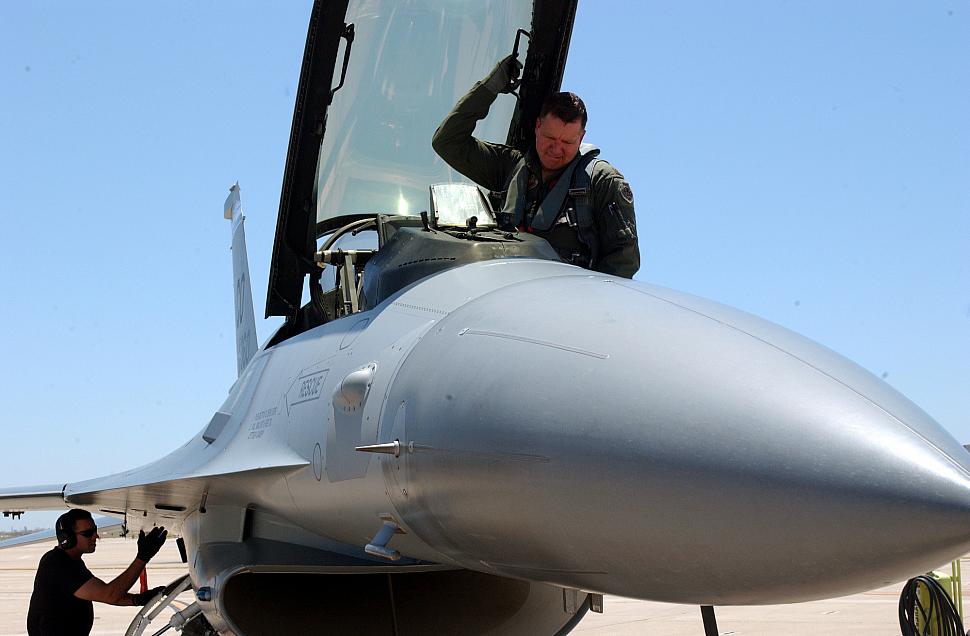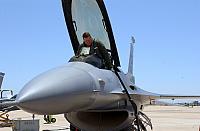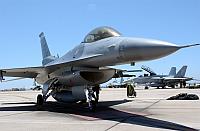Fighter Jet News
F-16 Fighting Falcon News
ANG F-16Cs take on F/A-18s in dissimilar training
June 2, 2005 (by
Lance Cpl. James B. Hoke) -
Marine pilots occasionally wonder what it would be like to fly against jets other than their own. Marine Corps Air Station Miramar aviators received the chance to test their curiosity May 11 to 24 against the Colorado Air National Guard's aircraft.

The guard unit traveled to Miramar to train in the skies with the Marines of Marine All Weather Fighter Attack Squadron 225, Marine Aircraft Group 11, 3rd Marine Aircraft Wing, flying their F-16C Falcons against the Marines' F/A-18 Hornets.
"What we are doing out here, primarily, is flying a dissimilar (flying against different aircraft) for combat training," said Air Force Maj. Mark Schuler, projects officer, 120th Fighter Squadron, 140th Aircraft Wing. "Hopefully, we are opening up lines of communication with the Marines here, so that we can do cross talks in terms of how we do tactics differently.
"We could pick the best tactics from the Air Force's side of the house and the way Marines do things," he added. "Then we could compare tactics and figure out the best overall way to do things and benefit from each other in the process."
The Air Force arrived at the air station with 180 airmen to perform various tasks of maintenance, ordnance, administration and logistics, so the Marines wouldn't have to lend extra hands to them, according to Schuler. They brought along eight F-16s to conduct "dissimilar" training with the Marines.
"To most folks, there is no noticeable difference between the F-16 and the F-18," said Maj. A. Che Bolden, operations officer, VMFA(AW)-225. "The main difference is our aircraft have two engines, two tails and two people, where the F-16s only have one of each."
According to Air Force Brig. Gen. Mike I. Edwards, commander, 140th Fighter Wing, both fighter jet models are designed to be strong in different areas of aerial combat.
"They are both superb airplanes," said Edwards. "In certain regimes the F-16 is better, in others the F-18 is better. In low-altitude, fast flights, the F-16 is more useful. In slow, maneuvering fights, the F-18 is the better. They are both very challenging aircraft to fight against. They both bring a lot of different things to the fight and are both capable of completing their mission."
Although the two branches of service primarily focused on the training, there was also the concern of how each would get along with one another.
"These guys are probably some of the most down-to-earth (Airmen) I've met," said Bolden. "They realize that we have our differences and do not get bent out of shape because of them.
"The Marine Corps is a little more structured than the Air Force," the Houston native, added. "The Air Force doesn't focus on the things that the Marine Corps does, but they have been a really good group of people to have around."
According to Air Force Lt. Col. Alan J. Buck, commander, 140th Maintenance Squadron, 140th Fighter Wing, the stay for the Air Force at Miramar has been terrific.
"All I can say is that (VMFA(AW)-225) and MAG-11 have been outstanding hosts," said Buck. "Everything we've asked of them, they've been able to get for us. The hospitality has been great. If the chance for us to ever return the favor to them arrived, we'd try to do the same."
According to Schuler, the Marines have given them great assistance during their stay aboard Miramar.
"As a projects officer, my job is to coordinate the arrival of everyone and make sure we have a place to operate out of and the equipment to basically get the mission done," Schuler concluded. "From the time we arrived, we've had the best support possible and a great place to work. The Marines here have been completely outstanding."

Air Force Maj. Mark Schuler, projects officers, 120th Fighter Squadron, 140th Aircraft Wing, Colorado Air National Guard, exits his F-16C Falcon at Marine Corps Air Station Miramar May 19, after returning from "dissimilar" training with the Marines of Marine All Weather Fighter Attack Squadron 225, Marine Aircraft Group 11, 3rd Marine Aircraft Wing. The Kailua, Hawaii, native, was one of the 180 Airmen who came to Miramar between May 11 and 24 to cross train with the Marines of VMFA(AW)-225 and MAG-11. [Photo by Lance Cpl. James B. Hoke
]
"What we are doing out here, primarily, is flying a dissimilar (flying against different aircraft) for combat training," said Air Force Maj. Mark Schuler, projects officer, 120th Fighter Squadron, 140th Aircraft Wing. "Hopefully, we are opening up lines of communication with the Marines here, so that we can do cross talks in terms of how we do tactics differently.
"We could pick the best tactics from the Air Force's side of the house and the way Marines do things," he added. "Then we could compare tactics and figure out the best overall way to do things and benefit from each other in the process."
The Air Force arrived at the air station with 180 airmen to perform various tasks of maintenance, ordnance, administration and logistics, so the Marines wouldn't have to lend extra hands to them, according to Schuler. They brought along eight F-16s to conduct "dissimilar" training with the Marines.
"To most folks, there is no noticeable difference between the F-16 and the F-18," said Maj. A. Che Bolden, operations officer, VMFA(AW)-225. "The main difference is our aircraft have two engines, two tails and two people, where the F-16s only have one of each."
According to Air Force Brig. Gen. Mike I. Edwards, commander, 140th Fighter Wing, both fighter jet models are designed to be strong in different areas of aerial combat.
"They are both superb airplanes," said Edwards. "In certain regimes the F-16 is better, in others the F-18 is better. In low-altitude, fast flights, the F-16 is more useful. In slow, maneuvering fights, the F-18 is the better. They are both very challenging aircraft to fight against. They both bring a lot of different things to the fight and are both capable of completing their mission."
Although the two branches of service primarily focused on the training, there was also the concern of how each would get along with one another.
"These guys are probably some of the most down-to-earth (Airmen) I've met," said Bolden. "They realize that we have our differences and do not get bent out of shape because of them.
"The Marine Corps is a little more structured than the Air Force," the Houston native, added. "The Air Force doesn't focus on the things that the Marine Corps does, but they have been a really good group of people to have around."
According to Air Force Lt. Col. Alan J. Buck, commander, 140th Maintenance Squadron, 140th Fighter Wing, the stay for the Air Force at Miramar has been terrific.
"All I can say is that (VMFA(AW)-225) and MAG-11 have been outstanding hosts," said Buck. "Everything we've asked of them, they've been able to get for us. The hospitality has been great. If the chance for us to ever return the favor to them arrived, we'd try to do the same."
According to Schuler, the Marines have given them great assistance during their stay aboard Miramar.
"As a projects officer, my job is to coordinate the arrival of everyone and make sure we have a place to operate out of and the equipment to basically get the mission done," Schuler concluded. "From the time we arrived, we've had the best support possible and a great place to work. The Marines here have been completely outstanding."
Courtesy of MCAS Miramar
Additional images:



Air Force Maj. Mark Schuler, projects officers, 120th Fighter Squadron, 140th Aircraft Wing, Colorado Air National Guard, exits his F-16C Falcon at Marine Corps Air Station Miramar May 19, after returning from "dissimilar" training with the Marines of Marine All Weather Fighter Attack Squadron 225, Marine Aircraft Group 11, 3rd Marine Aircraft Wing. The Kailua, Hawaii, native, was one of the 180 Airmen who came to Miramar between May 11 and 24 to cross train with the Marines of VMFA(AW)-225 and MAG-11. [Photo by Lance Cpl. James B. Hoke
]

Air Force Maj. Mark Schuler, a Kailua, Hawaii, native, winds down the engines on his F-16C Falcon May 19 after returning from a training flight at Marine Corps Air Station Miramar. The projects officer with 120th Fighter Squadron, 140th Aircraft Wing, Colorado Air National Guard, was one of the Airmen to visit Miramar May 11 to 24 to participate in "dissimilar" training with the Marines of Marine All Weather Fighter Attack Squadron 225, Marine Aircraft Group11, 3rd Marine Aircraft Wing, by flying the F-16 Falcons against the F/A-18 Hornets. [Photo by Lance Cpl. James B. Hoke
]
Related articles:
Tags
Tags
